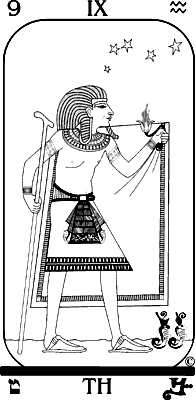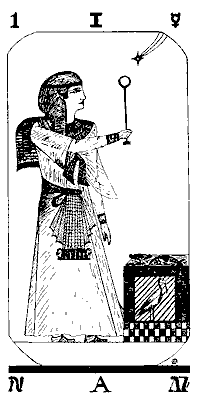
In Divination, Arcanum I may be read briefly as Will or Dexterity.
Arcanum I is pictured by a Magus, type of the perfect man, that is to say, in full possession of his moral and physical faculties. He is represented standing; it is the attitude of will which precedes action. His robe is white, image of purity, original or regained. A serpent biting its own tail serves him for a girdle; it is the symbol of eternity which alone circumscribes his endeavors. His forehead is girt with a circle of gold. Gold signifies light, and the circle expresses the universal circumference in which gravitate all created things.
The right hand of the Magus holds a scepter of gold, surmounted by a circle representing spirit; symbol of the authority conferred by spiritual attainment. He raises it toward heaven in the sign of aspiration to science, wisdom and force.
Above is a four-pointed star, its rays extending heavenward; it is the over-shadowing genius of his spiritual master directing his efforts and counseling him in his upward struggles. The left hand extends the index finger to the earth to show that the mission of the perfect man is to reign over the material world. This double gesture also expresses that the human will should reflect the Divine Will in order to procure good and prevent evil.
Before the Magus, upon a cubic stone, are placed a cup, a sword, and a piece of gold money in the center of which is engraved a cross. The cup signifies the mixture of the passions which contribute to happiness and unhappiness according as we are their masters or their slaves. The sword signifies the work, the struggle which traverses obstacles, and the trials which sorrow submits us to. The coin, sign of determined value, is the symbol of realized aspirations, of work accomplished; and shows the sun of power conquered by the perseverance and efficacy of the will. The cross, seal of the infinite, by which the coin is marked, announces the ascension of that power in the spheres of the future. The cube upon which these symbols rest typifies the physical world; and has graven on its side an ibis, to indicate that eternal vigilance is a necessity if physical limitations are to be surmounted.
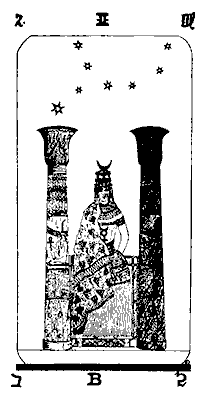
In Divination, Arcanum II may briefly be read as Science.
Arcanum II is figured by a woman seated at the threshold of the Temple of Isis. She is seated between two columns, the one on her right being red to signify pure spirit and its luminous ascension over matter, and the one on her left being black to represent the bondage of matter over the impure.
The woman is crowned by a tiara of three stories surmounted by a lunar crescent. From the tiara a veil falls over her face. She wears upon her bosom the symbol of the planet Mercury, and carries upon her knees an open book which she half covers with her mantle. This symbolic ensemble personifies occult science, which awaits the initiate at the threshold of the sanctuary of Isis in order to tell him the secrets of universal nature. The symbol of Mercury (Hermes) upon the bosom of the Virgin, signifies that matter is fecundated by spirit in order to evolve mind, or soul. The cross below is matter, the circle is spirit. Together they figure the lingam of the Hindus, representing the union of the sexes; and the crescent above the union of spirit and matter represents the soul which is the evolved product of their union.
The seal on the breast of Nature also expresses the thought that knowledge comes from God and is as limitless as its source. The veil falling over the face announces that Nature reveals her truths only to the pure in heart, and hides them from the curious and profane. The book half hidden under the mantle signifies that but half of the truth can be discerned by the physical senses, the exoteric side. The esoteric, or other half, must be apprehended through the application of the psychic senses. Reason, divorced from intuition, can discern only in the realm of effects; but re-wed to intuition, can remove the obscuring mantle from Nature's most secret page and pursue her mysteries at leisure.
These mysteries are revealed only in solitude, to the sage who meditates in silence in the full and calm possession of himself. The tiara represents the power of the intellect to penetrate the three realms of existence--physical, astral and spiritual--which are signified by its stories. The lunar crescent, symbolizing the feminine attribute, is above the tiara to indicate that in occult science the intellect should be guided by the intuitional, or psychic powers. That is to say, in the occult sciences the feminine qualities of the mind are often of superior value to the masculine, or rational.
The woman is seated to show that Will united to Science is Immovable.
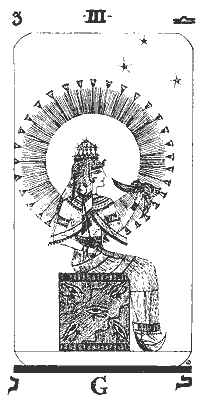
In Divination, Arcanum III may be read briefly as Marriage or Action.
Arcanum III is figured by a woman seated within a radiant sun. The rays from this sun number thirty, the number of degrees in one zodiacal sign. The woman is crowned with twelve stars, to represent the twelve signs through which the sun passes each year. Her feet rest upon the moon, symbol of the feminine in nature. And the cube upon which she sits represents the cross of matter, where rays of sun and moon meet, and so signifies the union of male and female forces.
From her brow the sacred serpent thrusts its head as a symbol of enlightenment. In her right hand she carries a scepter surmounted by a globe. This is essentially a phallus, and indicates the perpetual action of creative energy upon all things born or to be born. In her left hand she carries an eagle, the symbol of fruitfulness and of the heights to which the flights of the spirit can raise itself through the emotions engendered in union. The seat upon which she rests is covered with eyes, indicating that through union the eyes of the soul have been opened to a knowledge of good and evil.
This ensemble pictures, in terms of universal symbolism, generation, gestation, and universal fecundity.
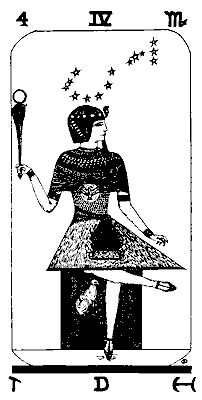
In Divination, Arcanum IV may be read as Realization.
Arcanum IV is figured by a man; on his head a sovereign's helmet. He is seated upon a cubic stone; his right hand raises a scepter surmounted by a circle, and his right leg bent, rests upon the other, forming with it a cross.
The cubic stone, image of the perfect solid, signifies labor which has reached completion. The cat, pictured on the side of the stone, indicates that the vision of the soul penetrates the illusions of matter.
The sovereign's helmet is an emblem of force conquered by power. The ruler is in possession of the scepter of Isis, indicating that he has knowledge of the spiritual use of the creative energies; and he points downward with his left hand to indicate that he uses these energies in the subjugation of the physical.
The sacred serpent at his brow indicates enlightenment; and the hawk, sacred to the sun, indicates his ambition to attain spiritual supremacy.
The cross, formed by his legs, symbolizes the four elemental kingdoms he has mastered, and the expansion of human power through understanding.
The apron above the legs, together with them, figures a trine above a cross; the symbol of mind dominating matter, and of the conservation of energy.
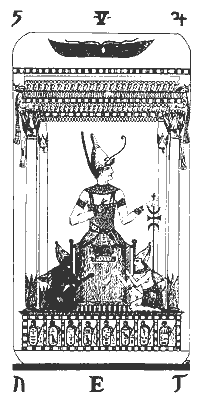
In Divination, Arcanum V may briefly be read either as Religion or Law.
Arcanum V is pictured by a hierophant, master of the sacred mysteries. This prince of the occult doctrine is seated between two columns of the sanctuary; he leans upon a cross of three bars, and with his right hand makes the sign of the pentagram. From his brow the sacred serpent thrusts its head; and at his feet kneel two men, one dressed in red and the other dressed in black.
The hierophant, supreme organ of sacred science, represents the genius of good inspiration, of mind, and of conscience. The column at the right symbolizes divine law, that on the left symbolizes the liberty to obey or to disobey.
The triple tau, or cross of three bars, is emblem of divine fire penetrating the three worlds, spiritual, astral, physical, in order that all manifestations of universal life may have their birth.
The left hand of the hierophant on the triple tau indicates
his receptivity to the divine force; and the gesture of his right hand--making
the pentagram-- indicates his use of this divine energy to command the
obedience of all sub-mundane atoms of life, and to hear the voice of heaven
in the silence of the passions and the instincts of the flesh.
The sacred serpent at his brow signifies enlightenment;
and the two kneeling men, the one red and the other black, denote the intelligences
of light and shadow, both of whom obey the force of the pentagram.
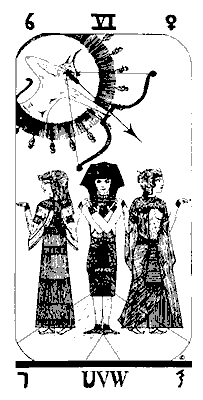
In Divination, Arcanum VI may be briefly interpreted as
Temptation.
Arcanum VI is figured by a man standing motionless at
the angle formed by the conjunction of two roads. His looks are fixed upon
the ground; his arms are crossed upon his chest. Two women, one at his
right and the other at his left, each place a hand on his shoulder, showing
him one of two roads. The woman at his right is modestly clothed, and has
the sacred serpent, indicating enlightenment, at her brow. She thus personifies
virtue. The one at the left wears less clothing, and is crowned with the
leaves and vine of the grape. She represents vice, the temptress.
Above and back of this group the genie of justice, hovering in a flashing aureole of twelve rays, draws his bow and directs toward vice the arrow of punishment. The genie is crowned with a flame to show he is a spirit; and is represented in an aureole of twelve rays to indicate that justice will be meted out in due time to all as the sun passes through the zodiacal signs.
This ensemble typifies the struggle between conscience and the passions, between the divine soul and the animal soul, and that the result of this struggle commences a new epoch in the life.

In Divination, Arcanum VII may briefly be read as Victory.
Arcanum VII is figured by a war chariot of square form, surmounted by a starry canopy sustained by four columns. Upon this chariot advances a conqueror armed with a cuirass and carrying both sword and scepter. He wears a crown from which rises three pentagrams, or golden stars with five points.
The square car symbolizes the material world vanquished by the work of the will. The four columns supporting the canopy represent the four quadrants of heaven which surround the conqueror. They also represent the four elemental kingdoms that have submitted to the master of the scepter and the sword.
Upon the square front of the chariot is pictured a sphere sustained by two outspread wings; symbol of the immortal flight of the soul through the infinitude of space and time. The sacred serpent at the conqueror's brow signifies the possession of that intellectual light which makes clear all the arcana of fortune. The three golden stars rising from the crown symbolize the dominion of man in all three worlds; physical, astral and spiritual.
A T-square and two try-squares are traced upon the cuirass. The T-square, or Tau, symbolizes virile force, and the two try-squares indicate the rectitude of judgment that enables the conqueror to direct this force either to right or left, into mental or physical power as occasion demands.
The cuirass signifies resistance; the high held sword
is the emblem of physical victory; and the scepter indicates mental conquest.
This scepter is surmounted by a square, a circle, and a triangle. The square
is the emblem of matter, the circle indicates the realm of spirit, and
the triangle is the emblem of mind; together denoting the perpetual dominion
of intelligence over all realms and forces of nature.
Two sphinxes, one white and the other black, are harnessed
to the car. A sphinx, as composed of the four emblems of the zodiacal quadrants,
indicates the passage of time. The white sphinx signifies fortunate periods,
and the black one signifies periods of adversity; both of which serve the
soul victorious over the ordeals met in its pilgrimage of eternal progression.

In Divination, Arcanum VIII may be read as Justice
or Equilibrium.
Arcanum VIII is figured by a woman, blindfolded and seated
upon a throne. She wears a crown of lance-heads, holds in her right hand
a raised sword, in her left hand a balance, and from her brow the sacred
serpent thrusts its head.
This is the ancient symbol of justice, which weighs all acts and opposes to evil as a counterweight the sword of expiation. Justice, emanating from God, as symbolized by the overshadowing protection, is the equilibrium between right and duty.
Justice is crowned with lances to indicate inflexibility,
adorned with the sacred serpent to signify she acts with enlightenment,
and her throne is placed on a platform or three steps to represent her
action in all three worlds. At her side is a lion, symbol of the force
over which she rules; and a sphinx, symbol of the passage of time which
enables her to manifest. Above is a winged turtle, symbol of the repentance
which may bring forgiveness. At the back is a divine messenger, signifying
that the justice of God will be the final judge of the justice of men.
The sword is here a sign of protection to the good and a menace to the
wicked.
The eyes of Justice are covered with a bandage to show
that she weighs and strikes without taking into account the conventional
differences that men establish for themselves.
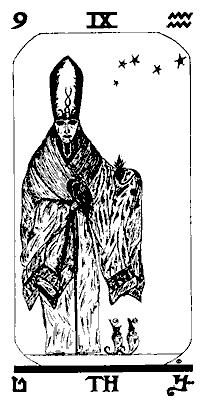
In Divination, Arcanum IX may briefly be read as Wisdom or Prudence.
Arcanum IX is figured by an old wanderer leaning on a staff and carrying before him a lighted lamp which he half conceals behind his mantle. This sage personifies experience gained in the journey of life. The cloak is of square form, symbolizing the physical world in which man may acquire knowledge of good and evil. That this knowledge has been gained is signified by the man having partially removed the cloak of material limitations, and by the lamp, emblem of intelligence, shedding its rays over the past, present and future. The lamp being concealed by the mantle symbolizes discretion, and also expresses the truth that if we are ever to know the real nature of anything we must delve deep beneath the cloak of external appearances.
The staff, which in form is the sixth letter of the Egyptian and Hebrew alphabets, indicates that man progresses through struggle, alternately overcoming obstacles and being vanquished by them, and that when finally he realizes he only develops his abilities through recurrent efforts to triumph over difficulties, this knowledge becomes his staff of prudence supporting him in all his endeavors.
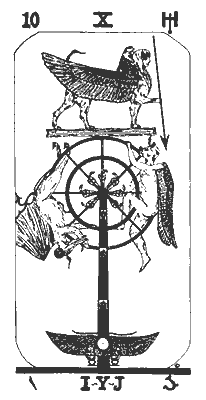
In Divination, Arcanum X may be read as Change of Fortune.
Arcanum X is figured by a wheel of eight spokes suspended by its axis upon a dual column. At the right Hernanubis, genius of good, strives to mount to the summit of the circumference. At the left, Typhon, genius of evil, is precipitated. On a circular platform in equilibrium on the Wheel, is poised a sphinx, holding in its claws a javelin. At the foot of the dual column two serpents raise their heads.
This is the wheel of destiny. The circular platform upon which the sphinx stands represents the zodiac; and the sphinx, as a composite of the four constellations marking the zodiacal quadrants-- Eagle, Lion, Man and Bull--signifies the passage of time.
It holds a javelin in its claws to indicate that time is always fructifying events and ever ready to strike to right or left as the wheel turns under its impulsion, raising the humble and lowering the proud.
The eight spokes of the wheel, eight being the number of justice, symbolize that time and opportunity, in the course of divine providence, are justly meted out to all. The dual column supporting the wheel indicates that all nature is polarized into positive and negative. The serpents signify that the law of all action is that of sex.
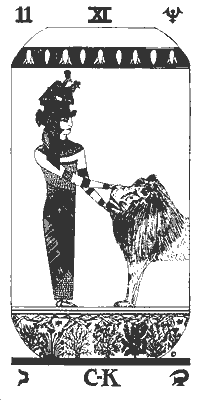
In Divination, Arcanum XI is Force, Spiritual Power, or Fortitude.
Arcanum XI is figured by the image of a young girl who opens and closes without effort, with her hands, the jaws of an angry lion. The maiden wears a crown surmounted by a vase and crowned eagles, and at her brow the sacred serpent.
The vase is symbol of the affections, and the crowned eagles represent force spiritualized. The sacred serpent signifies that she acts in full knowledge of her power, and not blindly. The lion symbolizes force, also the animal desires in man which are subdued by the spiritual nature.
The whole ensemble symbolizes the power over violent forces of nature that faith in oneself and an innocent life will give; also the spiritual power that is the natural result of unsullied affections which dominate and rule the animal instincts. It signifies that purity is the touchstone, and that goodness alone is power.
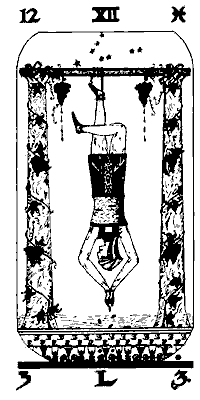
In Divination, Arcanum XII may be read as Sacrifice or Expiation.
Arcanum XII is figured by a man suspended by one foot from a gallows which is supported by two trees, each having six cut branches. His hands are tied together, forming a down-pointing triangle, above which one leg crosses the other in the form of a cross. From the hands gold pieces drop to the earth.
It is the sign of a violent death, coming unexpectedly by accident, or in the expiation of a crime, or accepted voluntarily through heroic devotion to truth and justice.
The twelve cut branches indicate the destruction of the twelve houses of the horoscope, signifying the extinction of life.
The cross above the triangle, a symbol the reverse of that on Arcanum IV, indicates that material forces have gained the ascendency and subdued the mind.
The coins dropping upon the earth signify wasted effort and the ebbing of the life forces. They also indicate that the efforts of the martyr who loses his life in furthering truth and justice are never lost, but remain on earth after he has passed. Ideals as yet unrealized persist in the astral about the earth until they contact some other person through whom they find suitable and more complete expression.
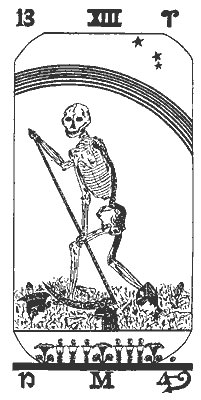
In Divination, Arcanum XIII may be read as Death or Transformation.
Arcanum XIII is figured by a skeleton reaping human heads, hands and feet. On the blade of the scythe wielded by Time is a serpent and a scarabeus, and back of all is seen a rainbow.
The progression of the scythe in its work is the emblem
of the perpetual destruction and rebirth of all forms of being in the domain
of time.
The serpent on the scythe represents the virile energy
that has carried the soul, symbolized by the scarab, in its pilgrimage
of births and deaths through the mineral kingdom, the vegetable kingdom
and the animal kingdom up to the estate of man.
The skeleton mowing human heads, hands and feet signifies that the thoughts, works and understanding of man eventually pass from the earth. But the rainbow promises a new life of thought, effort and knowledge in a superior realm.
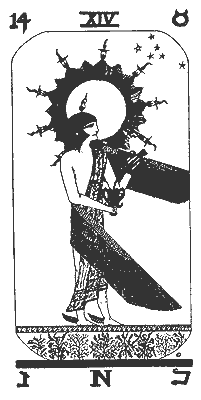
In Divination, Arcanum XIV is Regeneration or Temperance.
Arcanum XIV is figured by the genie of the sun holding a golden urn and a silver urn, and pouring from one to the other the conducting fluid of life.
The genie is crowned with flame to indicate that it is a spirit; and its feet are winged to signify its rapid movements. The fluid transferred from one urn to another is the symbol of transmutation; and the eight rays of the sun which show behind the genie's head signify that the positive, or masculine, forces of the universe are exactly equilibriated by the negative, or feminine, forces. The cloak over the shoulder of the spirit indicates the perpetual fecundation of matter, as symbolized by the cloak, by spirit.
This ensemble pictures the combination and interchange of masculine and feminine forces throughout nature, working ceaselessly in all kingdoms, as the instigators and cause of all movements and life.
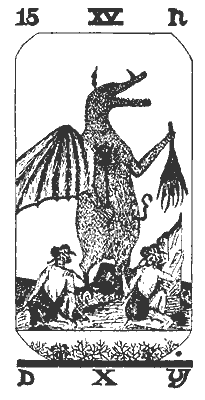
In Divination, Arcanum XV may be read as Fatality or Black Magic.
Arcanum XV is figured by Typhon, genius of evil, standing triumphantly over the ruins of a temple. In his right hand he holds a scepter surmounted by a circle resting between two divergent bars. These spreading bars signify the inversive forces that hem in and hamper the influence of spirit, represented by the circle. It is the emblem of hatred and division.
In the other hand this creature holds the torch of destruction, whose blaze has been applied to the ruins of the temple. He is crowned with flame to indicate he is not of this world, and he has the wings of a bat, to indicate he is a denizen of the realm of darkness. The horn on his nose signifies stubborn rebellion.
He has the breasts of a woman and the organs of a man, and is thus hermaphrodite, emblem of self-centeredness and a being devoid of love. The body is that of a hog, to denote greed. The feet are those of a goat, to indicate the sign Capricorn, the home sign of Saturn, or Satan; the sign most devoted to material ambitions. And the beings chained at the feet of this master of chaos also have goat heads, indicating that their intelligence has been used exclusively to further material and selfish ambitions.
This malignant entity has the head of a crocodile, symbol of cruelty. The snake emerging from his body, instead of from his brow, indicates the use of the creative energy, not for enlightenment, but for physical gratification. It also represents medium-ship, rather than conscious control; for the chief center of power in disintegrative mediumship is the solar plexus.
The two men with goat heads chained by the neck at the monster's feet represent the certain fate that awaits all who use magical powers to attain selfish or purely material ends. Sooner or later they become slaves of the very forces they have used, and are finally completely destroyed in body and mind; and even after passing to the next life, are chained by their evil deeds in the underworld.
All such evil entities, of this plane and the next, survive by preying on the ignorance and credulity of others, as shown by the sign of sorcery they make with their hands. They are racketeers and gangsters of both planes; and the ensemble, taken as a whole, indicates both the bondage and the fate of those who follow the inversive path and become dominated by the spirit of selfishness.
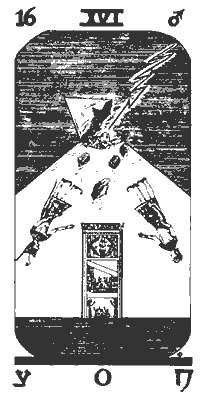
In Divination, Arcanum XVI may be read as Accident or Catastrophe.
Arcanum XVI is figured by a pyramid decapitated by a thunderbolt.
A crowned and uncrowned man are precipitated from a platform built of seven
stages, falling down with the rest of the debris.
A pyramid is the most stable of solids, is the symbol
of the earth, and also represents the climax of earthly security. As composed
of four trines, which are its sides, corresponding to the houses of a birth-chart,
it symbolizes the horoscope of physical life. From mineral up to man there
are seven degrees of mundane life, the seventh, or last stage of incarnation,
being that of man. After one incarnation of man, and thus gaining self-consciousness,
the soul continues its progress in higher-than-physical spheres. Thus the
platform on which the men were standing represents the last incarnation
in matter.
That the pyramid has been struck by lightning to the disaster of both a crowned and an uncrowned man, symbolizes that Nature is no respecter of persons, and that she strikes down both the high and the low, kings as well as subjects, who transgress her law. It is also the symbol of those rivalries which are so common among men, which divert energies into channels that result in ruin for all. It signifies sterile projects, ill-considered enterprises which are doomed to failure, ambitions which are frustrated, and death by catastrophe. And it represents the false security which results from material success and the reliance upon purely material science, as well as the sure punishment which is attracted ultimately by all those who use magical forces in the attainment of selfish ends.
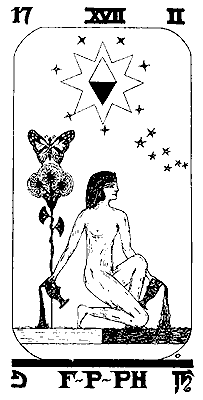
In Divination, Arcanum XVII may be read as Truth, Hope or Faith.
Arcanum XVII is figured by a blazing star of eight rays
in the center of which is a white trine with point upward joined at its
base to a black trine with its point downward. This star is surrounded
by seven other stars. It hovers over a nude young girl who has one foot
upon the sea and one foot upon the land, and who pours the fluid of universal
life from two cups, one of gold, the other of silver. Near the girl is
a flower of three blossoms, and above the upper one a butterfly opens its
wings.
This young girl is the emblem of truth. She is nude,
signifying that truth can be perceived only when stripped of the preconceived
ideas and dogmatic opinions with which it has been clothed by the artificialities
of civilization.
She rests partly upon the land and partly upon the sea to denote that truth is dual, the truth of reality and the truth of appearances, the truth of the practical and the truth of the ideal. The fluid is poured from a silver cup into the sea to indicate that the loving, emotional side of man's nature must be nourished if he is to grasp the inner truth. And it is poured from a golden cup upon the land to denote the necessity of cultivating the positive, reasoning intellect if he is to possess the external truth.
The fluid flowing from the golden cup represents the forces of man, and that from the silver cup the forces of woman; together revealing the truth of soul-mate-hood, and indicating how the finer energies of man rejuvenate woman and how the finer energies of woman rejuvenate man; their forces mutually sustaining each other and making a joint immortality possible.
The eight-point star symbolizes the Law of Equilibrium, the balance between spirit and matter, male and female, the inner and the outer. It is the book of the apocalypse sealed with seven seals, and thus represents the inner realization and the outer realization, the birth of the soul and the birth of the body, under the influence of the planets, represented by the 7 surrounding stars, or seals.
Each of these smaller stars, or seals, has four points, to signify that man should recognize the nature of its influence and realize how to direct it into channels of his own choosing.
The two trines of the larger star symbolize the Hermetic Axiom, "As it is below, so it is above," and reveal that evolution implies a preceding involution. It also indicates the necessity of experiences with both good and evil for soul progression.
The flower of three blossoms represents the three planes of existence from which the soul sips the nectar of wisdom, gaining thereby the strength to attain immortality, symbolized by the butterfly.
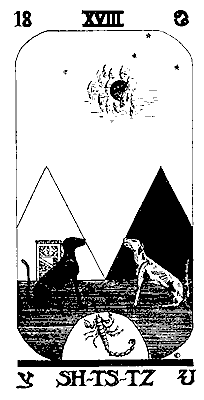
In Divination, Arcanum XVIII is Deception, False Friends, or Secret Foes.
Arcanum XVIII is figured by two pyramids at the edge of a road. The Moon above, half obscured by clouds, sheds a pale twilight. One of the pyramids, symbol of the twelve houses of the horoscope, is black, representing an ignorant and unspiritual life. The other pyramid is white, symbolizing a life enlightened by science and spiritual wisdom. In front of it is shown a door, or exit, indicating that those thus enlightened are not earth-bound, but pass freely, when their earthly life is completed, to a life in the higher spheres.
In the road before the pyramids are two dogs, one white and the other black; while between them, in a circle of white, crawls a scorpion. This dim, moonlight scene represents a seance room, the hidden perils of which are more redoubtable than those to be seen. The false radiance of the moon indicates the glamor that surrounds such an occasion. The good and the bad, the ignorant and the learned, symbolized by the pyramids, are gathered there at the edge of the road into the beyond. To such a place there may be attracted lying spirits, as signified by the black dog; friendly spirits, as denoted by the white dog; or treacherous and dominating spirits who have much knowledge, as indicated by the white circle in which the scorpion moves, but who use it to deceive arid attain their selfish ends.
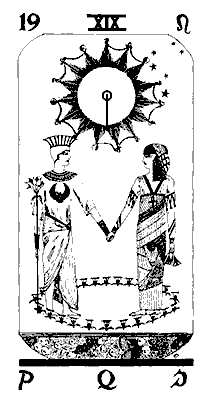
In divination, Arcanum XIX may be read as Happiness and Joy.
Arcanum XIX is figured by a young man and a young woman holding each other by the hand. About them a circle of 20 flowers springs from the earth. Above is a radiant Sun of 21 rays, in the center of which is the symbol of conjugal union. This sun is the symbol of perfect union expressed on all three planes; perfect harmony of physical desires, intellectual interests, and spiritual aspirations.
The young man and woman are plainly dressed, indicating simplicity of life, moderation of desires and purity of thought. The flowers springing up about them symbolize the joy and happiness of the domestic circle which more than compensate them for material hardships. The 20 flowers signify the potency of domestic harmony to Awaken and Resurrect the spiritual flora of the soul.
This ensemble personifies the fact that when the sexes are truly wed, and the triple laws of harmony are obeyed, that their lives are a constant round of happiness and joy, even amid adversities and privation.
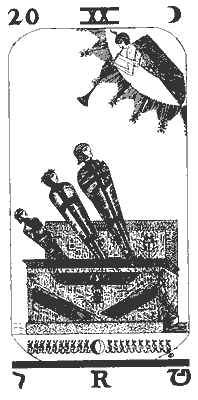
In Divination, Arcanum XX may be read as an Awakening or Resurrection.
Arcanum XX is figured by a sarcophagus on whose side is pictured a scarab. Above this tomb a genie sounds a trumpet, whereupon it opens and a man, woman and child rise from it, still dressed in their winding sheets.
The sarcophagus is the tomb through which man ascents to a higher life. The scarab is symbol of the immortality of the soul. The genie blowing the trumpet is the call to ascend to higher spheres. A man, woman and child arise together to indicate that immortality depends upon the trinity of positive and negative soul-monads united about their Deific ego. The innocence of the ego is represented by the child.
The real tomb is the physical body which confines and envelops the soul while it develops its powers through the functions of social life; its relations to other life-forms. After one life in human form it has acquired self-consciousness and has no need to return to earth. As indicated by the trinity rising from the grave, there are opportunities for family life and other experiences on the next plane, the total ensemble symbolizing this entering into a new and active life in a realm above matter.
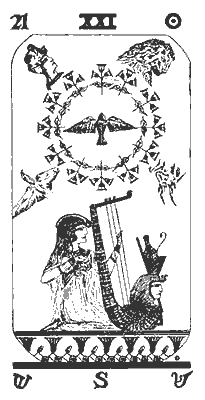
In Divination, Arcanum XXI may be read as Success or Attainment.
Arcanum XXI is figured by a kneeling young girl playing
on a harp of three strings. Above is a wreath of twelve flowers, each flower
having three blossoms. At each of the four angles of the wreath is a head;
the two below being the head of an eagle and the head of a bull, the two
above being the head of a lion and the head of a man. The man's head has
the sacred serpent at its brow to indicate mental fertility. In the center
of the wreath is a phallus and a yoni conjoined. This sacred lingha is
soaring upward through the wreath, sustained by two wings.
The young girl symbolizes purity of life. She is modestly
clothed to indicate simplicity of living and moderation in desires. She
kneels as she plays the harp to indicate absolute devotion to the higher
laws, and prayerful aspirations to live a spiritual life.
The harp has three strings, signifying harmony of body, intellect and emotions.
The twelve flowers of the wreath above are the twelve zodiacal signs in which all experience is gained. The three blossoms of each flower indicate that both souls, as represented joined in the winged linga, have garnered the flowers of zodiacal experience on all planes, physical, astral and spiritual.
The head of the Lion signifies the creative forces of the solar sign, Leo, and the courage which is necessary to all real attainment. The head of the Bull represents the fructifying agent of nature and points out the necessity of labor in all progress. The Eagle signifies that sex, as signified by the sign Scorpio, has been turned into channels which lead to spirituality. And the head of the Man indicates that both intuition and intelligence are necessary guides in unfolding the highest spiritual possibilities.
These four emblems ranged around the zodiac typify the processes of evolution. They are the four forms of the Egyptian sphinx, and also symbolize the passage of the Sun through the four zodiacal quadrants. As applied to adeptship they point out that the neophyte must have energy and courage to sustain his efforts, must have knowledge to direct his energies properly, must labor ceaselessly for the realization of his aspirations, and must gradually tune his emotions to a higher, more spiritual vibratory level. Those four attributes, Wisdom, Perseverance, Courage, and Love are usually rendered in occult circles as: "To Know, To Do, To Dare, To be Silent."
The winged linga in the center of the wreath of zodiacal flowers symbolizes the permanent union of soul-mates and their ascension into angelic worlds by virtue of the properties of the soul-mates system so formed. The girl kneeling by the harp denotes that this union was brought about by living the life of the spirit while on earth. Spiritual aspirations and devotion to furthering God's Great Plan, loving and unselfish endeavor to contribute the utmost to cosmic welfare, together with a clear conception of the laws of harmony, in time bring about the recognition across the spaces and the development of exchanging lines of force, which lead to this ineffable union. This harmonious reverberation of soul to soul is symbolized by the harp of three strings, for the union embraces all three planes.
Strength depends upon harmony, and the music of their
souls sounding across the spaces endows both with a hitherto unknown power
to overcome obstacles, to gain the blossoms of experience on all three
planes, as signified by the three flowers related to each of the 12 zodiacal
signs. As a whole the ensemble signifies the attainment of adeptship while
on earth, and the crown of angelhood that awaits such perfect human beings
when they have passed from the physical and function in the sublime vistas
of the future.
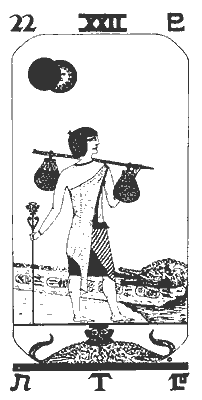
In Divination, Arcanum XXII means Failure, Folly, and Mistake; (or Spirituality).
Arcanum XXII, or 0, like the planet Pluto, has a dual interpretation. As XXII, it is well represented by the letter T with its point thus down; but as 0, the circle being the symbol of spirit, it is represented by the reversed T, that is, having the point, or energy, directed upward, the cross-bar resting below on the earth, and thus indicating that the thoughts, emotions and actions, are directed exclusively toward spiritual endeavor. It is figured by a blind man carrying bags on his left shoulder. He leans on a black staff and walks toward a fallen obelisk behind which a crocodile with open mouth awaits to devour him. Above is an eclipse of the Sun. The eclipse signifies that the spiritual light from within has been obscured by material interests; or it signifies that dark forces from the inner plane try to shut away the spiritual illumination which guides the neophyte.
The bags over the left shoulder of the blind man indicate the material things of life he has spent his efforts acquiring; or it represents his ability to minister in physical ways to those in need.
The staff of experience with good and evil is black, indicating that prudence is subservient to the demands of the senses; or that the demands for uplifting and protecting others is so great that, though enlightened, he ignores all danger.
The fallen obelisk symbolizes the final overthrow of all temporal work and power. The crocodile indicates the ultimate fate of all who are blind to spiritual things, and also the persecution of those who work to spread the true facts of spirituality.
This blind man is the atheist, or materialist, and the man who is so absorbed in material aims that he neglects all thought of spiritual things. It is likewise the man who is a slave to his desires. And the ensemble thus symbolizes the inevitable suffering which follows sin. Or, it symbolizes the truly spirit ual man, who is so enthusiastic in his effort to assist the race that he is completely blind to the consequences to himself. And thus, equally well, it symbolizes the law of universal compensation, which decrees that for all effort expended in a constructive channel there inevitably follows increased ability and real advancement.

